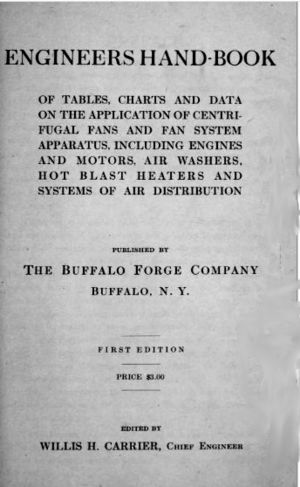Willis Carrier facts for kids
Quick facts for kids
Willis Carrier
|
|
|---|---|

Carrier in 1915
|
|
| Born |
Willis Haviland Carrier
November 26, 1876 Angola, New York, U.S.
|
| Died | October 7, 1950 (aged 73) New York City, U.S.
|
| Resting place | Forest Lawn Cemetery, Buffalo, New York |
| Nationality | American |
| Alma mater | Cornell University (M.E.) |
| Occupation | Engineer |
| Known for | Inventing modern air conditioning |
| Spouse(s) |
Edith Claire Seymour
(m. 1902; died 1912)Jennie Tifft Martin
(m. 1913; died 1939)Elizabeth Marsh Wise
(m. 1941) |
| Children | 3 |
| Awards | ASME Medal (1934) Frank P. Brown Medal (1941) |
Willis Haviland Carrier was an American engineer. He is famous for inventing modern air conditioning. In 1902, he created the first electric air conditioning unit. Later, in 1915, he started the Carrier Corporation. This company makes and sells systems for heating, ventilation, and air conditioning (HVAC).
Contents
Early Life and Education
Willis Haviland Carrier was born on November 26, 1876. His hometown was Angola, New York. He finished high school in Buffalo in 1897.
He then went to Cornell University in 1897. He earned a Master of Engineering degree in 1901.
How Air Conditioning Began
After college, Carrier started working as a research engineer. He joined the Buffalo Forge Company.
In 1902, a printing company in Brooklyn, New York, had a big problem. The summer humidity made their paper grow and shrink. This caused blurry images when printing colors. Willis Carrier designed a solution. On July 17, 1902, he drew plans for the world's first modern air conditioning system.
This invention was special because it controlled humidity. Experts realized that air conditioning needed to do four main things:
- control temperature
- control humidity
- control air movement and fresh air
- clean the air
Carrier kept working on his invention. On January 2, 1906, he received a patent for his "Apparatus for Treating Air." This was the first spray-type air conditioning machine. It could add moisture to the air or remove it.
In 1906, Carrier made an important discovery. He found that keeping the "dew-point depression" constant also kept the humidity constant. This idea became known as the "law of constant dew-point depression." He used this law to design an automatic control system.
In 1908, the Carrier Air Conditioner Company of America was formed. It was a part of the Buffalo Forge Company. Willis Carrier became its vice president.
In 1911, Carrier shared a very important paper. It was called Rational Psychrometric Formulae. This paper connected ideas like relative humidity and dew point. It made it possible to design air conditioning systems that fit exact needs.
Starting His Own Company
World War I began in late 1914. The Buffalo Forge Company decided to focus only on manufacturing. So, Willis Carrier and six other young engineers decided to start their own company. They put together their savings, which was $32,600.
On June 26, 1915, they formed the Carrier Engineering Corporation. The company was based in New York. Later, it moved to Newark, New Jersey.
Challenges and Growth
In the 1920s, air conditioning started to cool large buildings. But the company faced money problems after the Wall Street Crash of 1929. In 1930, Carrier Engineering Corp. joined with two other companies. They formed the Carrier Corporation. Willis Carrier became the chairman of the board.
The Great Depression slowed down the use of air conditioning in homes and businesses. In 1937, Carrier moved his company to Syracuse, New York. The company grew and became a major employer in the area.
At the 1939 New York World's Fair, Carrier had an igloo-shaped exhibit. It showed people what air conditioning could do. But then World War II started. After the war, in the 1950s, air conditioning became very popular. Today, air conditioning and HVAC systems are common in many homes and businesses.
Willis Carrier's Legacy
Willis Carrier's work had a huge impact. In 1930, he helped start companies in Japan and Korea. Today, South Korea is a top producer of air conditioning units. The Carrier Corporation led the way in designing machines to cool large spaces. Air conditioning changed American life by helping factories produce more in the summer.
The Carrier Corporation became part of United Technologies in 1980. In 2020, it became an independent company again. It is still a world leader in HVAC and refrigeration. In 2018, the company had sales of $18.6 billion and employed 53,000 people.
A lab at Syracuse University is named after him. It's called the Willis H. Carrier Total Indoor Environmental Quality Lab.
Personal Life
Willis Carrier married Edith Claire Seymour in 1902. She passed away in 1912. He then married Jennie Tifft Martin in 1913, who died in 1939. His third wife was Elizabeth Marsh Wise, whom he married in 1941. Willis Carrier and all three of his wives are buried in Forest Lawn Cemetery in Buffalo, New York.
Carrier had one child, Howard Carter Willis. He also adopted two children from Jennie Martin: Vernon and Earl.
Willis Carrier died on October 7, 1950. He was buried in Buffalo, New York.
Awards and Recognition
Willis Carrier received many honors for his work.
- He earned an engineering degree from Lehigh University in 1935.
- He received an honorary Doctor of Letters degree from Alfred University in 1942.
- He was given the Frank P. Brown Medal in 1942.
- After his death, he was added to the National Inventors Hall of Fame in 1985.
- He was also inducted into the Buffalo Science Museum Hall of Fame in 2008.
See also
 In Spanish: Willis Haviland Carrier para niños
In Spanish: Willis Haviland Carrier para niños


